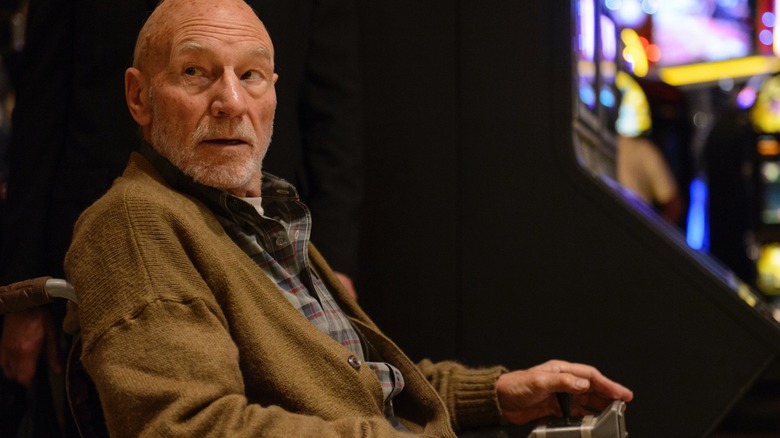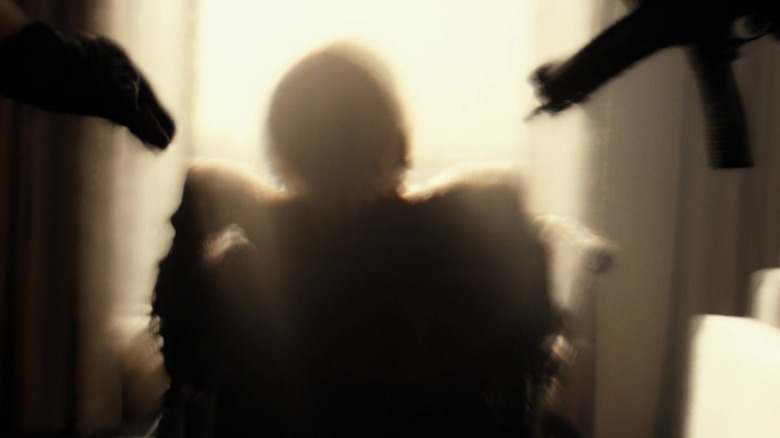One Of Logan's Best Special Effects Wasn't Done With CGI
James Mangold's 2017 film "Logan" remains one of the best of all superhero movies, exploring the final days of a superpowered vigilante with sadness and a sense of futility. It seems that being a costumed crimefighter for multiple decades forces a superhero to live by a code of violence. What happens to a person if they've devoted their lives to fighting and fighting and fighting? It seems that it might hollow out a person's soul. It makes sense that superheroes die tragically.
"Logan" is set in 2029, a time when superpowered mutants have stopped being born. The final generation of mutants is aging out, and of the original X-Men, only Logan (Hugh Jackman) and Professor X (Patrick Stewart) remain in contact. Logan is losing his ability to heal quickly and it's only a matter of time before he sustains an injury that kills him. The Professor is now quite elderly, and can't control his psychic abilities any longer. He occasionally suffers seizures which shake the earth, topple walls, and can even kill people. The Professor now has dementia and lives in an abandoned smelting plant in the deserts of New Mexico. Later in the film, one of the Professor's seizures mentally paralyzes an entire hotel/casino.
The Professor's seizures are visualized in "Logan" by a violent shaking of the frame, accompanied by a kind of visual "echo" effect to imply that it is psychically instigated and not a mere earthquake. There is also a loud, blaring noise, showing that the seizures are painful for anyone who happens to be nearby.
According to Mangold, via a post on Twitter.com, aka X, the "echo" effect was achieved not through conventional CGI, but via an automated consumer-grade "shake-reduction" camera app.
The casino sequence
One can watch the completed casino sequence online. In the scene, Professor X has a seizure in his hotel room right when armed S.W.A.T.-like agents are infiltrating. Logan is in the lobby below when the seizure strikes and everyone in the hotel is frozen in place. He fights his way up to the hotel room, pushing through the psychic "quivering," murdering the agents, and rescuing the Professor.
On Twitter, Mangold revealed the pre-visualization video of the sequence. Pre-viz videos are kind of like a living storyboard, letting the filmmakers work out the pacing and camera angles of a scene before filming it with the actual actors. In the case of "Logan," Mangold wanted to show off how the psychic attacks might look if he shook his cameras violently and then applied the shake-reduction software. The look is decidedly eerie. Mangold tweeted:
"Because this film was made for much less than other tent pole films, we had to find new ways to achieve vfx. The psionic attack was largely created by shaking the camera like crazy & then using a shake-reduction app to make the shake disappear but retaining the smeary look."
The kind of app Mangold refers to is quite common. One can download digital video stabilizers from the Google Store and through Apple. Indeed there are many services online that can unblur photographs and movies. Mangold, taking a relatively low-fi approach to "Logan" ultimately created something that looked unique and dynamic for much less money than extensive CGI might have. Bigger budgets and overwhelming CGI effects don't always make a superhero movie look better and can often serve to make a film look worse. The psionic earthquakes in "Logan" look far, far better than, say, M.O.D.O.K.

